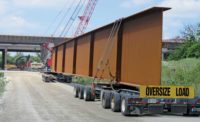In the weeks since the Trump administration announced a 25% tariff on raw steel imports, it has exempted several countries from the duties. They include the European Union nations as well as Argentina, Australia, Brazil, South Korea and North American Free Trade Agreement partners Canada and Mexico. China has challenged the tariffs through the World Trade Organization. But the biggest impact for the U.S. construction industry will be in the cost of fabricated steel.
The American Institute of Steel Construction is still pushing to have fabricated steel from China and other nonexempt countries added to the products subject to tariffs. The resulting price increase for imports would help U.S. fabricators.
In a letter to President Trump, AISC President Charles Carter and David Zalesne, chair of the trade group’s board of directors, urged the administration to include fabricated structural steel among the products covered by the tariff. They said that if fabricated products are not included, rising domestic prices could hurt U.S.-based fabricators. They said it also would leave a gaping hole in the tariff that could encourage the fabrication of large assemblies in other countries with no duties applied.
“By just stopping the tariff at the mill level, the market is still open to circumvention of those tariffs by bringing in fabricated material from other countries,” says Zalesne, who also is president of Columbia, S.C., fabricator Owen Steel.
AISC believes the tariffs are disproportionately harming small U.S. fabricators who only buy U.S.-made steel, while fabricators that carry offshore products can absorb price increases more easily. Carter, Zalesne and other U.S.-based fabricators have met with officials in the U.S. Trade Representative’s office and the Commerce Dept., but they do not foresee any immediate change in policy. The Commerce Dept. did not respond to an ENR request for comment.
“There are people in the office of the U.S. Trade Representative and the Commerce Dept. who understand these issues well but … this is an easier tariff to manage than a fabricated steel tariff and it will take more time to see how it plays out before they do anything else,” Zalesne says.




